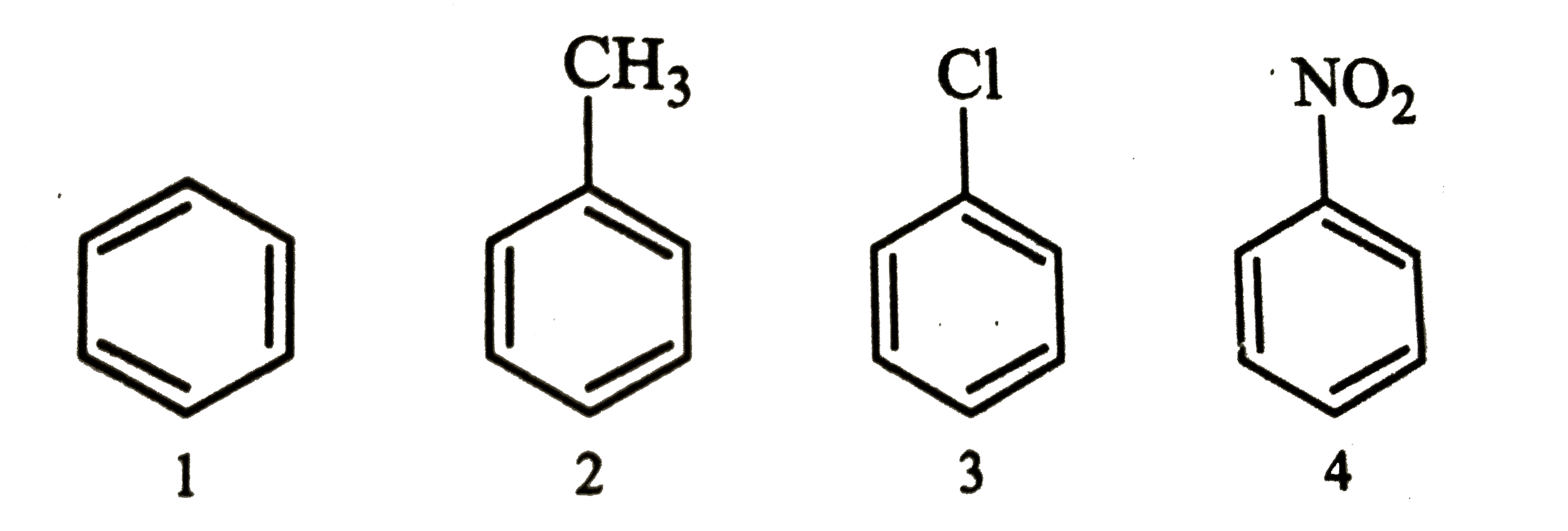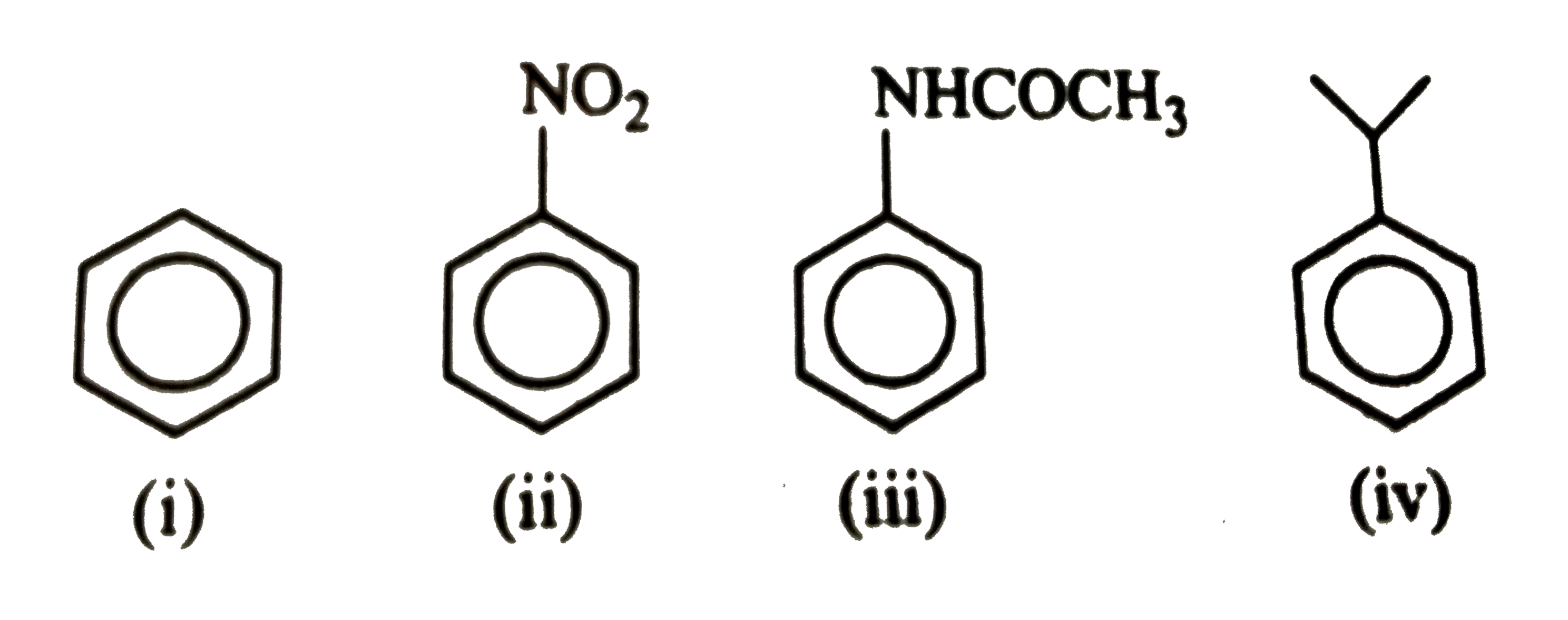Complete Solutions to Competition Focus (JEE(main and advanced)/Medical Entrance) III. MULTIPLE CHOICE of chapter HYDROCARBONS of Class 11 book with complete answers and questions
| Class 11 | CHEMISTRY |
| Chapter | HYDROCARBONS |
| PRADEEP | Competition Focus (JEE(main and advanced)/Medical Entrance) III. MULTIPLE CHOICE |
| Number Of Questions | 14 |
| Academic Year | 2023-24 |
Catalytic hydrogenation involves addition of hydrogen to a gt C = Clt or -C `-=` C- bond in presence of a metal catalyst such as Ni, Pt, Pd, etc. These are called heterogeneous catalysts. Both `H_2` and alkene/alkyne get adsorbed on the surface of the metal , and syn-addition of hydrogen atoms takes place. The relative rates of hydrogenation follows the order:
`-C-=C- gt gt C=C lt gt C= o lt C_6H_6`
If sodium or lithium in liquid ammonia is used, anti-addition of H-atoms occurs across `-C-=C-`bond. These reducing agents can also be used to reduce double bonds of benzene rings and conjugated dienes but not of isolated dienes.
Which of the following alkenes will react most readily with `H_2` under catalytic hydrogeneration conditions ?
View SolutionCatalytic hydrogenation involves addition of hydrogen to a ` C = C or -C -= C- `bond in presence of a metal catalyst such as Ni, Pt, Pd, etc. These are called heterogeneous catalysts. Both `H_2` and alkene/alkyne get adsorbed on the surface of the metal , and syn-addition of hydrogen atoms takes place. The relative rates of hydrogenation follows the order:
`-C-=C- gt gt C=C lt gt C= o lt C_6H_6`
If sodium or lithium in liquid ammonia is used, anti-addition of H-atoms occurs across `-C-=C-`bond. These reducing agents can also be used to reduce double bonds of benzene rings and conjugated dienes but not of isolated dienes.
`[A]underset"Catalyst"overset"Lindlar's"larrCH_3-C-=C-CH_3underset(liq. NH_3)overset" Na in"to [B]`
[A] and [ B] are respectively
View SolutionCatalytic hydrogenation involves addition of hydrogen to a `C = C or -C -= C-` bond in presence of a metal catalyst such as Ni, Pt, Pd, etc. These are called heterogeneous catalysts. Both `H_2` and alkene/alkyne get adsorbed on the surface of the metal , and syn-addition of hydrogen atoms takes place. The relative rates of hydrogenation follows the order:
`-C-=C- gt C=C gt C= O gt C_6H_6`
If sodium or lithium in liquid ammonia is used, anti-addition of H-atoms occurs across `-C-=C-`bond. These reducing agents can also be used to reduce double bonds of benzene rings and conjugated dienes but not of isolated dienes.
The catalytic hydrogenation of which of the following alkenes is most exothermic ?
View SolutionCatalytic hydrogenation involves addition of hydrogen to a gt C = Clt or -C `-=` C- bond in presence of a metal catalyst such as Ni, Pt, Pd, etc. These are called heterogeneous catalysts. Both `H_2` and alkene/alkyne get adsorbed on the surface of the metal , and syn-addition of hydrogen atoms takes place. The relative rates of hydrogenation follows the order:
`-C-=C- gt gt C=C lt gt C= o lt C_6H_6`
If sodium or lithium in liquid ammonia is used, anti-addition of H-atoms occurs across `-C-=C-`bond. These reducing agents can also be used to reduce double bonds of benzene rings and conjugated dienes but not of isolated dienes.
Which of the following functional groups is most easily reduced.
View SolutionAromatic hydrocarbons are highly unsaturated molecules but behave like saturated hydrocarbons. Those which contain a benzene ring are called benzenoids but those which contain some highly unsaturated ring other than benzene are called non-benzenoids. Their aromatic character can be ascertained through Hückel rule. Aromatic hydrocarbons are, however, more reactive than alkanes but are less reactive than alkenes and alkynes. The lower reactivity of arenes is because of the extra stability associated with these molecules due to delocalization of -electrons. Their stability is measured in terms of resonance energy which can be estimated from either heat of combustion or heat of hydrogenation data. They normally undergo electrophilic substitution reactions. In presence of a Lewis acid catalyst, nuclear halogenation occurs but in absence of Lewis acid catalyst and in presence of light, halogens add to the benzene ring. If an aromatic hydrocarbon contains an alkyl side chain, then in presence of heat/light side chain halogenation occurs in preference to addition of halogens to the benzene ring. The reactivity of aromatic hydrocarbons towards electrophilic substitution reactions depends upon the electron density in the benzene ring. Electron-donating groups favour while electron-withdrawing groups retard these reactions. Orientation of electrophilic substitution reactions is governed by the nature of the substituent already present in the ring. Although aromatic hydrocarbons are resistant to oxidising agents `(KMnO_4, K_2Cr_2O_7`, etc.) they do undergo ozonolysis.
The enthalpy of hydrogenation of cyclohexene is `-119.5 "kJ mol"^(-1)`.If resonance energy of benzene is `-150.4 "kJ mol"^(-1)`, its enthalpy of hydrogenation would be
View SolutionAromatic hydrocarbons are highly unsaturated molecules but behave like saturated hydrocarbons. Those which contain a benzene ring are called benzenoids but those which contain some highly unsaturated ring other than benzene are called non-benzenoids. Their aromatic character can be ascertained through Hückel rule. Aromatic hydrocarbons are, however, more reactive than alkanes but are less reactive than alkenes and alkynes. The lower reactivity of arenes is because of the extra stability associated with these molecules due to delocalization of -electrons. Their stability is measured in terms of resonance energy which can be estimated from either heat of combustion or heat of hydrogenation data. They normally undergo electrophilic substitution reactions. In presence of a Lewis acid catalyst, nuclear halogenation occurs but in absence of Lewis acid catalyst and in presence of light, halogens add to the benzene ring. If an aromatic hydrocarbon contains an alkyl side chain, then in presence of heat/light side chain halogenation occurs in preference to addition of halogens to the benzene ring. The reactivity of aromatic hydrocarbons towards electrophilic substitution reactions depends upon the electron density in the benzene ring. Electron-donating groups favour while electron-withdrawing groups retard these reactions. Orientation of electrophilic substitution reactions is governed by the nature of the substituent already present in the ring. Although aromatic hydrocarbons are resistant to oxidising agents `(KMnO_4, K_2Cr_2O_7`, etc.) they do undergo ozonolysis.
Which of the following is not a non-benzenoid aromatic compound ?
View SolutionAromatic hydrocarbons are highly unsaturated molecules but behave like saturated hydrocarbons. Those which contain a benzene ring are called benzenoids but those which contain some highly unsaturated ring other than benzene are called non-benzenoids. Their aromatic character can be ascertained through Hückel rule. Aromatic hydrocarbons are, however, more reactive than alkanes but are less reactive than alkenes and alkynes. The lower reactivity of arenes is because of the extra stability associated with these molecules due to delocalization of -electrons. Their stability is measured in terms of resonance energy which can be estimated from either heat of combustion or heat of hydrogenation data. They normally undergo electrophilic substitution reactions. In presence of a Lewis acid catalyst, nuclear halogenation occurs but in absence of Lewis acid catalyst and in presence of light, halogens add to the benzene ring. If an aromatic hydrocarbon contains an alkyl side chain, then in presence of heat/light side chain halogenation occurs in preference to addition of halogens to the benzene ring. The reactivity of aromatic hydrocarbons towards electrophilic substitution reactions depends upon the electron density in the benzene ring. Electron-donating groups favour while electron-withdrawing groups retard these reactions. Orientation of electrophilic substitution reactions is governed by the nature of the substituent already present in the ring. Although aromatic hydrocarbons are resistant to oxidising agents `(KMnO_4, K_2Cr_2O_7`, etc.) they do undergo ozonolysis.
Reaction of benzene with excess of `Cl_2` in presence of light and in presence of anhydrous `AlCl_3` and in dark give respectively
View SolutionAromatic hydrocarbons are highly unsaturated molecules but behave like saturated hydrocarbons. Those which contain a benzene ring are called benzenoids but those which contain some highly unsaturated ring other than benzene are called non-benzenoids. Their aromatic character can be ascertained through Hückel rule. Aromatic hydrocarbons are, however, more reactive than alkanes but are less reactive than alkenes and alkynes. The lower reactivity of arenes is because of the extra stability associated with these molecules due to delocalization of -electrons. Their stability is measured in terms of resonance energy which can be estimated from either heat of combustion or heat of hydrogenation data. They normally undergo electrophilic substitution reactions. In presence of a Lewis acid catalyst, nuclear halogenation occurs but in absence of Lewis acid catalyst and in presence of light, halogens add to the benzene ring. If an aromatic hydrocarbon contains an alkyl side chain, then in presence of heat/light side chain halogenation occurs in preference to addition of halogens to the benzene ring. The reactivity of aromatic hydrocarbons towards electrophilic substitution reactions depends upon the electron density in the benzene ring. Electron-donating groups favour while electron-withdrawing groups retard these reactions. Orientation of electrophilic substitution reactions is governed by the nature of the substituent already present in the ring. Although aromatic hydrocarbons are resistant to oxidising agents `(KMnO_4, K_2Cr_2O_7`, etc.) they do undergo ozonolysis.
In the reaction of `C_6H_5Y`, the major product ( gt 60%) is m-isomer , so the group Y is
View SolutionWhich of the following is not aromatic ?
View SolutionWhich one of these is not compatible with arenes
View SolutionIdentify the correct order of reactivity in electrophilic substitution reactions of the following compounds :

View SolutionEthylbenzene with bromine in the presence of `FeBr_(3)` predominantly gives
View SolutionMatch the following columns

View Solution
The correct order towards electrophilic substitution is
View Solution
Competition Focus (JEE(main and advanced)/Medical Entrance) III. MULTIPLE CHOICE questions and complete solutions for chapter HYDROCARBONS of PRADEEP CHEMISTRY (HINGLISH) of Class 11
All Exercises from PRADEEP Class 11 CHEMISTRY HYDROCARBONS
- ADDITIONAL QUESTIONS (LONG ANSWER QUESTIONS)
- ADDITIONAL QUESTIONS (SHORT ANSWER QUESTIONS)
- ADDITIONAL QUESTIONS (VERY SHORT ANSWER TYPE QUESTIONS )
- ADVANCED PROBLEMS FOR COMPETITION
- ANALYTICAL QUESTIONS AND PROBLEMS WITH ANSWERS/SOLUTIONS (PROBLEMS)
- ANALYTICAL QUESTIONS AND PROBLEMS WITH ANSWERS/SOLUTIONS (QUESTIONS)
- Competition Focus (JEE(main and advanced)/Medical Entrance) III. MULTIPLE CHOICE
- Competition Focus (JEE(main and advanced)/Medical Entrance) IV. MATCHING TYPE QUESTIONS
- Competition Focus (JEE(main and advanced)/Medical Entrance) V. MATRIX-MATCH TYPE QUESTIONS
- Competition Focus (JEE(main and advanced)/Medical Entrance) VI.INTEGER TYPE QUESTIONS
- Competition Focus (JEE(main and advanced)/Medical Entrance) VII.NUMERICAL VALUE TYPE QUESTIONS
- Competition Focus (JEE(main and advanced)/Medical Entrance) VIII. ASSERTION - REASON TYPE QUESTIONS
- Competition Focus (JEE(main and advanced)/Medical Entrance) I. MULTIPLE CHOICE QUESTIONS
- Competition Focus (JEE(main and advanced)/Medical Entrance) II. MULTIPLE CHOICE
- CONCEPTUAL Questions
- CURIOSITY QUESTIONS
- NCERT EXEMPLAR PROBLEMS WITH ANSWERS, HINTS AND SOLUTIONS (MULTIPLE CHOICE -I)
- NCERT EXEMPLAR PROBLEMS WITH ANSWERS, HINTS AND SOLUTIONS (MULTIPLE CHOICE -II)
- NCERT EXEMPLAR PROBLEMS WITH ANSWERS, HINTS AND SOLUTIONS (ASSERTION AND REASON TYPE QUESTIONS)
- NCERT EXEMPLAR PROBLEMS WITH ANSWERS, HINTS AND SOLUTIONS (LONG ANSWER QUESTIONS )
- NCERT EXEMPLAR PROBLEMS WITH ANSWERS, HINTS AND SOLUTIONS (MATCHING TYPE QUESTIONS)
- NCERT EXEMPLAR PROBLEMS WITH ANSWERS, HINTS AND SOLUTIONS (SHORT ANSWER QUESTIONS)
- NCERT QUESTION AND EXERCISES WITH ANSWERS
- NCERT QUESTION AND EXERCISES WITH ANSWERS (NCERT EXCERCISES)
- PROBLEMS FOR PRACTICE
- SAMPLE PROBLEM
- TEST YOUR GRIP (FILL IN THE BLANKS )
- TEST YOUR GRIP (MULTIPLE CHOICE )